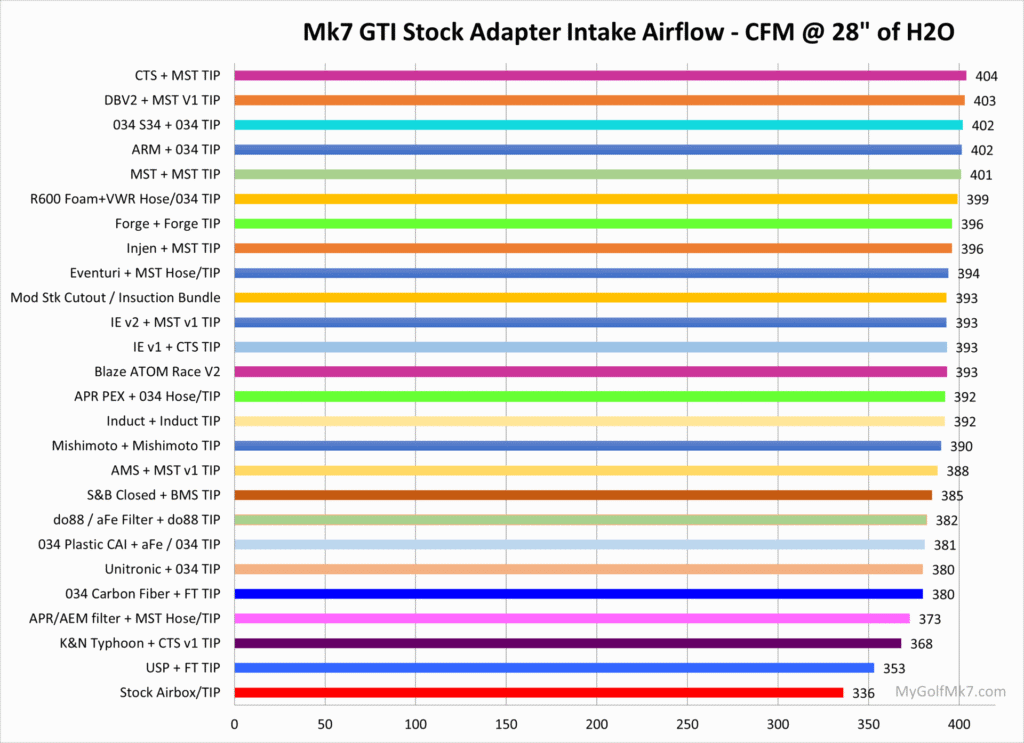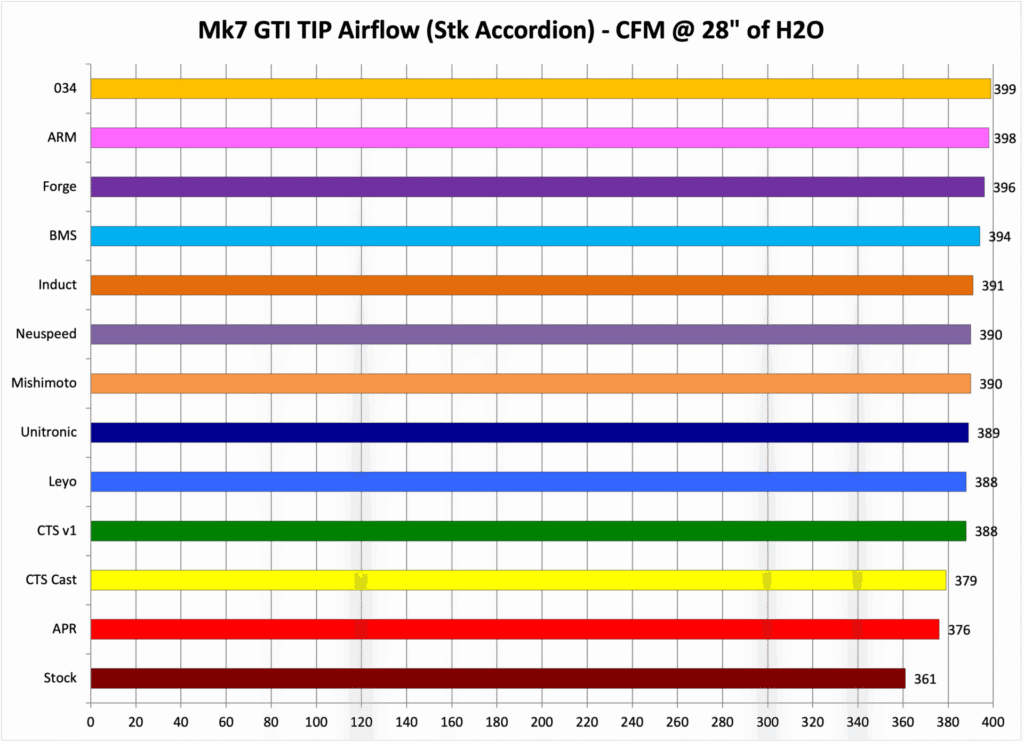Background:
This post continues to examine the performance of the Blaze ATOM Race V2 intake. It compares the boost onset rate using the Blaze intake with an APR Carbon Fiber closed intake, using an ECS inlet hose and CTS turbo inlet pipe (TIP).

This comparison was motivated by Equilibrium Tuning owner Ed Susman’s advertised claim that the Blaze ATOM Race intake reduced boost onset by 100 to 200 RPM compared to a competitor’s intake.
Ed Susman referred to the comparison setup as a Unitronic Intake and a Unitronic TIP.
Here is Ed Susman’s claim:


Data presented to support the claim is shown below.
Note: As the consumer observed, it’s impossible to determine if the starting engine speed was the same for the two cases since the boost pressure is at 7 psi at the start (in the chart to the right). The other intake pull showed a boost of slightly more than 7 psi at the beginning of the data.
Test Articles:
I don’t have the Unitronic parts on hand, but looking at how the Unitronic Intake and TIP perform relative to others, I have some components that flow slightly less than the Unitronic parts.
The APR Carbon Fiber closed intake flows less than the Unitronic, and the CTS V2 (Cast) TIP flows less than the Unitronic TIP.
Using these two parts, comparing the Blaze ATOM Race should show at least the 100-200 RPM difference that EQT advertises if the claim is valid.

The final piece of this setup is the ECS Tuning turbo inlet hose.
Test Process:
The CTS Turbo inlet elbow is installed on the Mabotech M520H turbocharger.

Then the APR Carbon Fiber intake and ECS Tuning inlet hose are installed.

The GTI is then driven for approximately fifteen minutes before generating boost onset data.
The GTI is operated in third gear out of boost. The accelerator is fully depressed, and boost pressure builds to 20 psi. After that, the accelerator is released, causing boost pressure to drop.
This process is repeated several times at engine speeds starting between ~2,000 and ~3,000 RPM.
The GTI is then reconfigured using the Blaze ATOM Race intake, and the data collection process is repeated.
Test Results:
The chart below shows an overview of the data collection session using the APR intake, showing the variation of boost pressure over time and the outside air temperature during the data collection.

Next is a chart showing the same data during the Blaze intake data collection session.

This chart compares the boost onset with the APR intake (blue line) and Blaze ATOM intake (orange line). The starting engine speeds are within 15 RPM of each other.

Because there are approximately 50 data points, showing all the curves on the same chart would make the results extremely difficult to interpret.
A format I prefer for comparing boost onset data is calculating the time it takes for the boost pressure to increase from 1 psi to 20 psi, accounting for the engine speed when the boost pressure is at one psi.
This results in a curve showing the time it takes for the boost pressure to increase as a function of the starting engine speed. This comparison chart is shown below:

The dashed lines are trend lines based on a second-order polynomial fit. There is a negligible difference in the boost onset time across the 2000-3000 RPM engine speed range.
The following chart shows the same data in a format of the amount of RPM that passes during the boost rise from 1 psi boost to 20 psi of boost with the circle symbols.

The green line shows where reducing the boost onset RPM by 100 would place the orange circles. Reducing the boost onset by 200 RPM would put the orange circles on the blue line.
There is no significant difference in the boost onset for the tested configurations.
Conclusions:
Equilibrium Tuning claims the Blaze ATOM Race intake can lower boost onset by 100-200 RPM compared to a competitor’s aftermarket intake and inlet elbow.
To check Equilibrium Tuning’s claim, a worse-performing intake setup compared to the one EQT’s customer used was assembled.
Fifty-one (51) data points were logged, and no significant difference existed between the Blaze ATOM and the alternative intake. This result contradicts Equilibrium Tuning’s claims.
EQT presents incomplete data that is insufficient for this type of comparison. It also consists of a single data pair, which is inadequate for a reliable conclusion because it ignores variability and consistency.
Consumers should consider it unlikely that the Blaze ATOM Race V2 intake will reduce boost onset by 100-200 RPM compared to other aftermarket intake options.
References:
- Blaze ATOM Race intake product page
- APR Carbon Fiber intake product page
- CTS Turbo inlet elbow product page
- Blaze ATOM vs Stock Airbox
- Blaze ATOM vs Modified Stock Airbox
- Blaze ATOM In Depth Part 2 – Inlet Flange Effects
- Blaze ATOM In Depth Part 3 – PCV Port Vacuum
- Blaze ATOM In Depth Part 4 – Ram Air Pressure
- Blaze ATOM In Depth Part 5 – Crankcase Vacuum
- Blaze ATOM In Depth Part 6 – Pre-Turbo Air Temperature





You used a turbo with a smaller inducer and completely different intake setup for your testing. Trying to draw conclusions about completely different hardware is hardly scientific.
Perhaps a disclaimer of that kind belongs on the Blaze ATOM product page.
The advertising claim gives the impression it benefits ‘turbochargers requiring additional airflow’.
Lacking the disclaimer, this is False Advertising.
Can the intake really affect the speed at which the desired pressure is reached?
Without modifying the internals of the turbocharger, is it even possible to change these RPM values?
In principle there is a contribution from the intake to the compressor pressure ratio, which effects the power required to rotate the compressor. The operating range where the boost initially builds is at a low pressure ratio, so the intake makes a negligible contribution. The test conclusion that the intake didn’t make a difference is consistent with operating conditions. The most likely cause of the difference between the conclusion I reached and the conclusion made by EQT is that the measurement and/or data analysis by the vendor was/were flawed.